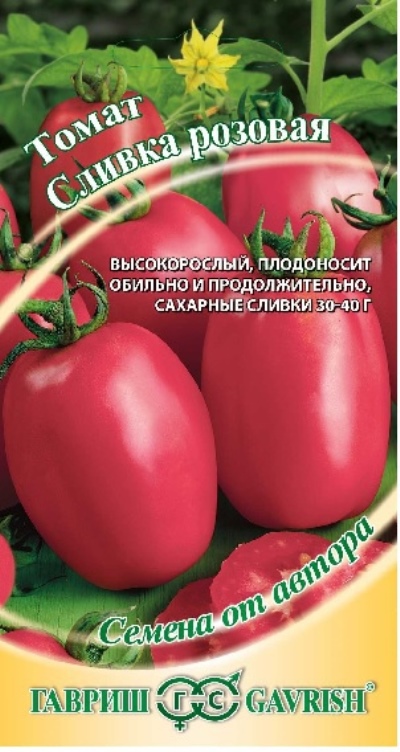
- Authors: Gavrish S.F., Morev V.V., Amcheslavskaya E.V.
- Year of approval: 1997
- Category: grade
- Growth type: indeterminate
- Appointment: fresh consumption, for pickling and preserving
- Ripening period: mid-early
- Ripening time, days: 100-107
- Growing conditions: for open ground, for film greenhouses
- Bush size: tall
- Bush height, cm: more than 100
Tomato varieties, bred in the late 1990s, deserve attention no less than the freshest selection samples. This fully applies to Rosy Cream, the developers of which can be justifiably proud of their product. But to get a good result, farmers will have to study this plant especially carefully.
Breeding history
The variety was bred thanks to the efforts of the breeders of Morev, Amcheslavskaya and Gavrish. They had to work during the most difficult periods for domestic plant breeders. But nevertheless, they performed their task clearly and competently. Pink cream has been registered and approved for use at home since 1997.
Description of the variety
This plant:
differs in the indeterminate dynamics of development;
cultivated both in open ground and in greenhouses;
forms bushes more than 1 m high;
differs in an average level of branching and the same foliage;
semi-spreading;
has leaves with weakly expressed corrugation (they are colored green and devoid of stipules).
The main qualities of the fruit
Berries of the Pink Cream variety fully correspond to its name and have a pink color. Other parameters of tomatoes:
shape like a typical plum;
usual weight 30-40 g;
formation from complex inflorescences;
articulated stalk type;
the appearance of the first inflorescence above 8-9 leaves;
the emergence of subsequent inflorescences every 3 leaves.
Taste characteristics
The pulp of this tomato is sugary. In terms of juiciness, it is also not inferior to advanced "rivals". The smooth skin does not make any significant contribution to the overall flavor of the berries. In general, the flavoring ensemble is bright and expressive. The proportion of dry matter usually reaches 5%.
Ripening and fruiting
Pink cream is considered a medium early tomato. Most often, the ripening of the crop (after throwing out the green growth) takes from 100 to 107 days. But both the meteorological factor and the agricultural technology used can affect the result very significantly. If everything is done correctly, it will take a long time to harvest the fruits.
Yield
The declared level of productivity is 2-2.5 kg per 1 sq. m. This result under normal conditions with normal growth dynamics is achieved quite stably. The correct choice of the site plays an important role.
The timing of planting seedlings and planting in the ground
Sowing seeds in containers or boxes is necessary in the last days of March. Seedlings are usually ready for transfer to open soil in late April or early May. But a lot depends on how the development of culture goes.

Growing tomato seedlings is an extremely important process, because it largely depends on whether the gardener will be able to harvest at all. All aspects must be taken into account, from seedbed preparation to planting in the ground.
Landing scheme
Suppliers of planting material strongly recommend planting Pink Cream according to the rule of 400x600 mm. Experienced summer residents follow this advice and get a good result. There is no point in doing amateur experiments.

Growing and care
The susceptibility of this variety to tobacco mosaic contamination is justifiably alarming. It is necessary to deal with the prevention of such an infection in the first place. However, prevention of fusarium wilting, especially during periods of massive outbreaks of such an infection, is also imperative. The bushes are tied up a few days after planting. They must be formed strictly in 1 stem, removing all excess growth and pinching the growth points at the end of the growing season.
Water the tomato pink cream should be systematically. But between waterings, the soil should dry out at least a little. Top dressing is applied once every 14 days. The choice of organic or mineral mixtures is at the discretion of the farmers themselves. Proper mulching is essential to maintain moisture and aerate the root system.




A plant needs different micronutrients at each stage of growth. All fertilizers can be divided into two groups: mineral and organic. Folk remedies are often used: iodine, yeast, bird droppings, eggshells.
It is important to observe the rate and period of feeding. This also applies to folk remedies and organic fertilizers.


Growing regions
Pink cream can be recommended for cultivation for summer residents and gardeners:
north and northwest of the European part of Russia;
Western and Eastern Siberia;
The Far East;
various localities of the Urals, the Volga region and the North Caucasus;
Kursk, Voronezh, Tambov regions.
Review overview
In general, this variety is rated favorably. Those who tried to grow it in one year, in the future, invariably became its adherents. The plant can at least compete on an equal footing with other small-fruited tomatoes. If you follow simple agronomic measures, you can get a decent harvest exactly on time.

























































































